Essential Guide to Cross-Border E-Commerce Logistics in 2025
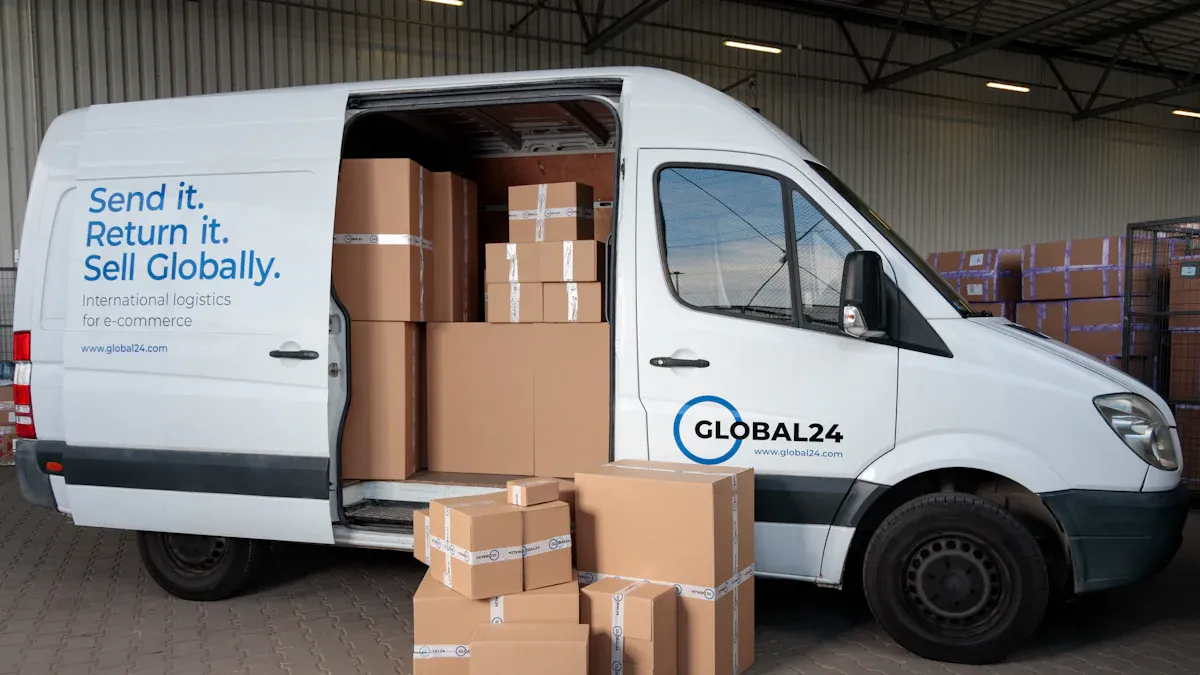
You must pay close attention to reliability, visibility, and compliance to do well in cross-border e-commerce logistics. Fast and clear cross-border shipping helps customers trust you. Real-time tracking and good communication help you meet what customers want and stop delays. Smart platforms and solutions like JUSDA and China-Europe Express Rail make it easy to handle global operations.
Metric | Value | Year/Period |
|---|---|---|
Global cross-border e-commerce market size | 2025 (estimate) | |
Share of global online sales | 31.2% | 2025 |
Retail e-commerce sales worldwide | > $7 trillion | 2025 (projected) |
Cross-border e-commerce market size | $1.98 trillion | 2024 (estimated) |
Projected market size | $5.06 trillion | 2028 (forecast) |
CAGR (2022-2028) | 25.1% | 2022-2028 |
Growth rate relative to global e-commerce | 219% faster | Through 2028 |
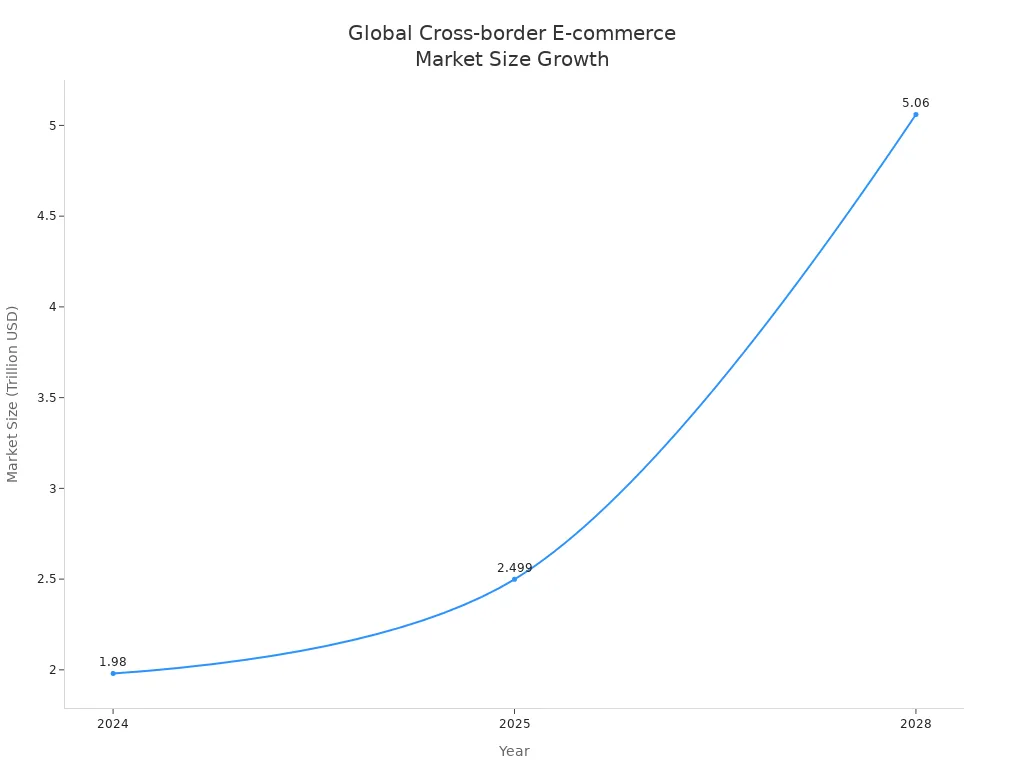
Key Takeaways
Cross-border e-commerce is growing quickly. More people buy things from other countries. Shoppers want free delivery, trust, and easy returns.
Smart platforms, AI, and automation help a lot. New shipping options like JUSDA’s China-Europe Express Rail make deliveries faster. They also lower costs and make tracking better.
Clear communication is important. Good customs management and easy returns help customers trust the process. These things make cross-border logistics smoother and more reliable.
Cross-Border E-Commerce Logistics Trends
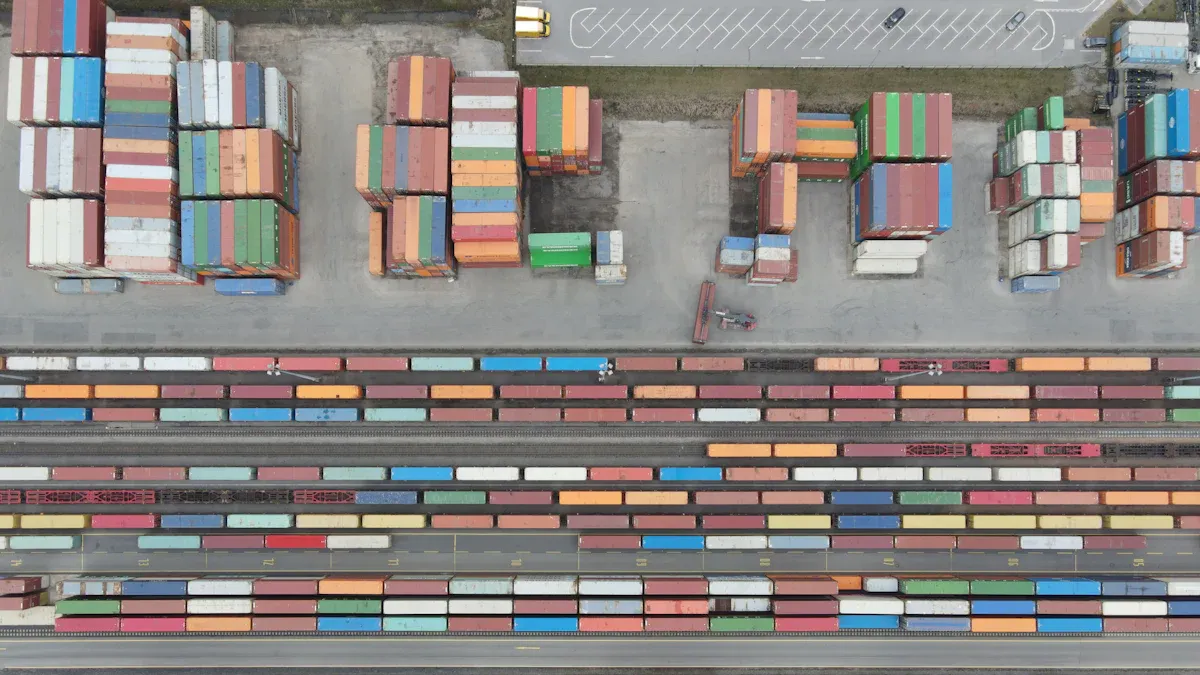
Market Growth
Cross-border ecommerce is growing very fast in 2025. More people are shopping from stores in other countries. About 59% of shoppers worldwide buy things from other countries. Around 35% of them do this every month. The global market could reach $4.81 trillion by 2032. Buyers care most about free delivery, trust, and easy returns. These things make companies work harder to improve their services.
Here is a look at the market growth:
Year | Market Size (USD Billion) | CAGR (%) (2025-2034) |
|---|---|---|
2024 | 98.4 | N/A |
2034 | 1000 | 26.10 |
Asia Pacific is growing the fastest with a 27.9% rate. This is because China has a strong e-commerce market. North America and Europe are also getting bigger. Latin America and the Middle East are growing as more people use the internet. There are more chances for cross-border sales in these places as digital trade grows.
Technology Shifts
Big changes are happening in cross-border ecommerce technology. Companies use international warehousing and decentralized storage to save money and deliver faster. Many work with third-party logistics providers for better inventory, packaging, and customs help. Multimodal transport uses air, sea, rail, and ground to move goods quickly and safely.
Tip: IoT devices and blockchain help make cross-border logistics safer and clearer. Sensors watch shipments all the time. Blockchain keeps records safe and easy to check.
Artificial intelligence helps guess what people will buy, plan routes, and run warehouses. AI chatbots help customers in many languages. Automation and digital customs systems help stop delays and mistakes. These tools make cross-border ecommerce work better and faster. When you use these technologies, you can give customers what they want: speed, trust, and clear tracking.
Key Challenges in Cross-Border Logistics
Customs & Compliance
There are many customs and compliance problems in cross-border e-commerce. Each country has its own customs rules. These rules can change often. You must know about new laws, like the U.S. lowering the de minimis threshold. The U.S. also adds tariffs for shipments from Canada, Mexico, and China. Switzerland now wants all mail-order platforms to register for VAT. The EU’s VAT Import One-Stop Shop makes tax collection easier. But it also makes things more complicated. You need good partners like customs brokers and local agents. They help you avoid delays and fines. Some common problems are:
Customs requirements and border rules are different everywhere.
Expensive goods like electronics and apparel need strict origin checks.
Using advanced data and risk management helps you keep up with new rules.
Note: Good paperwork and correct product classification help you avoid big mistakes in cross-border shipping.
Shipping Costs
Shipping costs in cross-border logistics can change fast. Air freight costs more than ocean freight. Customs fees and surprise charges add to your costs. You can save money by getting bulk rates and using shipping aggregators. Packing your items better also helps. Regional warehouses make delivery faster and cheaper. Here is a quick look:
Shipping Method | Cost Level | Delivery Speed |
|---|---|---|
Air Freight | High | Fastest |
Ocean Freight | Low | Slowest |
Standard/Economy | Lowest | 1-5 days |
Cross-Border Shipping | Varies (customs) | Varies |
Working with third-party logistics providers can help you save money and work better.
Returns Management
Handling cross-border returns is hard. There is more paperwork, customs, and taxes than with local returns. Cross-border e-commerce has a return rate of 25%. This is much higher than local sales. Clothes and shoes have even more returns. The main problems are:
Logistics are complicated and take longer.
Shipping, duties, and taxes cost more.
Language problems and unclear return rules make things harder.
Clear communication and simple return policies help you build trust and lose less money in cross-border fulfillment.
Solutions for Cross-Border Ecommerce
Smart Platforms
Smart platforms help you run cross-border ecommerce better. These platforms use new technology like automation, big data, blockchain, IoT, and AI. They help you keep track of inventory and fill orders fast. You can see where your shipments are at any time. Companies like Amazon and Alibaba use AI to plan routes and make choices quickly. Blockchain keeps records safe and helps with customs and payments.
Smart platforms let you see all your shipments in one place. You can track packages from many carriers and countries. Automation sends updates to your team and customers. This way, everyone knows where the order is. Predictive analytics warn you if there might be a delay. You can fix problems before they get worse.
Note: Smart platforms work best with strong teams and good partners. Technology alone cannot fix every problem in cross-border ecommerce.
Here are some ways smart platforms help you:
Automation cuts down on manual work and speeds up messages.
Real-time updates help your customers trust you more.
Predictive tools help you stop delays before they happen.
Connecting to your online store gives buyers live delivery info.
JUSDA’s JusLink platform uses IoT, cloud computing, and big data. It gives you real-time visibility and helps you work well with suppliers and logistics partners. This platform helps with demand forecasting, delivery planning, and customs tracking. You can manage your cross-border e-commerce business with more confidence and less risk.
JUSDA’s China-Europe Express Rail
If you want to ship goods between China and Europe faster, try the China-Europe Express Rail. JUSDA made this service to connect big cities in China to Europe by rail. It gives you a good balance between speed and cost.
Let’s look at the main shipping options:
Shipping Method | Average Cost per 20ft Container | Typical Transit Time |
|---|---|---|
Rail Freight | $3,000 – $5,000 | |
Sea Freight | $1,000 – $2,500 | 30-45 days |
Air Freight | $12,000 – $30,000 | 3-7 days |
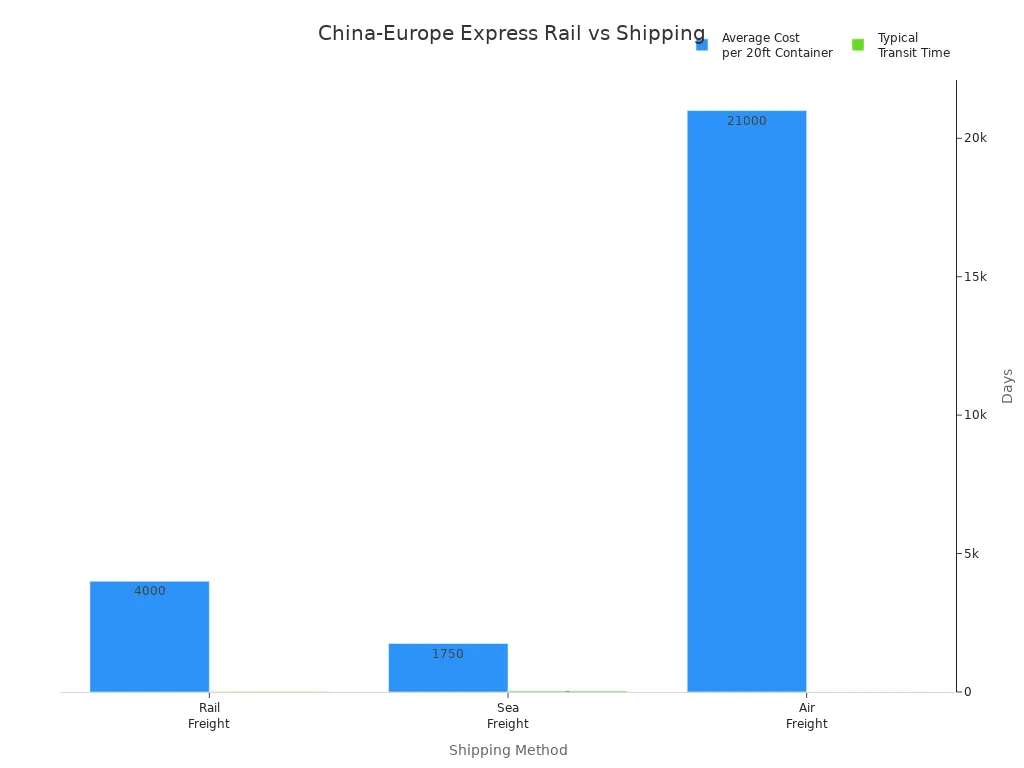
Rail freight takes about 15 to 20 days. This is much faster than sea freight and costs less than air freight. You can move electronics, clothes, and medical supplies quickly and safely. JUSDA’s network helps you avoid customs delays and keeps your goods moving. The China-Europe Express Rail also works with sea-rail intermodal solutions. This means you can send goods from Japan, South Korea, and Southeast Asia to Europe.
Tip: Rail freight helps you react faster to market changes. It also cuts down the time your products stay in storage. Rail is better for the environment than air freight.
Automation & AI
Automation and AI are changing cross-border ecommerce. You can use AI to translate languages and answer customer questions. AI chatbots help your customers any time. Automation makes packing, labeling, and tracking shipments faster.
AI helps you guess what people will buy and plan inventory. It finds the best delivery routes using live data. This means you can deliver orders faster and make fewer mistakes. AI also checks customs rules and fills out documents. This helps you avoid delays at the border.
Here are some ways automation and AI help you:
Real-time translation helps you talk to people in other languages.
Automated pricing and payment save time and cut down on mistakes.
Predictive analytics help you keep the right amount of stock.
Robots in warehouses help fill orders faster.
AI-powered tracking gives you and your customers accurate delivery times.
Advancement Area | Description | Example / Data Point |
|---|---|---|
Automation in Fulfillment | Robots pick and move goods in warehouses to increase speed and accuracy | Amazon uses over 200,000 robots; Alibaba invests billions in smart warehouses |
AI-driven Supply Chain | AI predicts demand and plans routes for faster shipping | AI improves customs clearance and delivery times |
ESG Reporting Support | Machine learning tracks and reduces waste and emissions | AI helps companies reach net-zero targets |
Robotic Picking Facilities | Automated picking systems boost order fulfillment | Asendia invests in robotic picking facilities |
Callout: AI and automation help you make fewer mistakes and deliver faster. They help you keep your promises to customers and build trust in your cross-border e-commerce business.
When you use smart platforms, new rail services like JUSDA’s China-Europe Express Rail, and the latest automation and AI tools, you can solve many cross-border ecommerce problems. These solutions give you more control, faster deliveries, and happier customers.
Optimizing Cross Border E-Commerce
Supply Chain Visibility
You need to see your whole supply chain to do well. If you watch every step, you can fix small problems early. End-to-end visibility means you track products from start to finish. Most companies use digital dashboards for updates. But not many have full visibility. Here are some tips to help:
Share data with all partners to work better together.
Pick good logistics providers and use tracking tools.
Make customs clearance simple to stop delays.
Link all your systems for a clear supply chain view.
Use smart logistics and automation to work faster.
When you see your supply chain clearly, you spot risks fast. You can stop delays and make customers trust you. You also help the environment by fixing problems quickly.
Inventory Management
Good inventory management keeps your business running well. Real-time tracking helps you avoid running out or having too much. You can put warehouses in important places to save money and deliver faster. Demand forecasting helps you guess what people will buy. This way, you stock the right things. Try these ideas:
Use automated systems to order more stock.
Ship popular items in bulk and special ones directly.
Work with flexible warehouse partners for short-term needs.
Big companies like Shein and Temu build local centers. This helps them deliver faster and avoid customs delays.
Collaboration
Working with logistics partners makes cross-border ecommerce easier. You can use digital platforms to connect orders, shipping, and storage. Sharing data and resources helps everyone work smarter and faster. Automation and dashboards let you track everything in one place. This teamwork saves money, improves delivery, and helps you grow your business.
Enhancing Customer Experience

Fast Delivery
You want your customers to get their orders fast. Fast delivery in cross-border ecommerce depends on a few things. You can use air and road together for urgent packages. Land and sea work well for big shipments. Pick logistics partners who know the area and have good systems. Use digital tools like real-time tracking and AI to plan routes. Keep inventory close to where people buy to cut down delays. Airports with pre-clearance and lots of flights help too.
JUSDA worked with Sharp to use these ideas. Sharp got faster by using JUSDA’s smart logistics and automation. Orders arrived 30% quicker and there were fewer delays.
Tip: Fast delivery helps customers trust you and buy again.
Transparent Tracking
You should let customers know where their orders are. Transparent tracking gives real-time updates and sends automatic messages. Customers can see their package at every step. Branded tracking pages help your business look good and keep customers loyal. These systems also answer common questions, so customer service gets fewer calls.
PostalParcel’s global tracking made “Where’s my order?” emails drop by 43%. Repeat purchases went up by 22%. When tracking is clear, customers feel safe and important.
Easy Returns
You can make returns easy for your customers by doing a few things:
Use tech for automatic return steps and tracking.
Give clear return policies in the local language.
Offer prepaid return labels to make it simple.
Give store credit right away for quick refunds.
JUSDA helped Sharp with better return management. This saved money and made customers happier. Easy returns make people want to shop with you again and trust your cross-border ecommerce store.
Future of Cross-Border Logistics
Sustainability
By 2025, sustainability will be very important in cross-border logistics. Companies want to lower their carbon footprint and follow new rules. They use digital tools like blockchain, AI analytics, and IoT tracking. These tools help make customs faster and supply chains easier to see. Here are some top ways companies try to be more green:
Companies use fuels like electric vehicles, hydrogen, and renewable diesel.
Smart tech like AI route planning helps save fuel and cut emissions.
Logistics hubs use renewable energy for their work.
New tracking tools, like shipment dashboards, help watch greenhouse gas output.
Businesses report clearly, especially about Scope 3 emissions in supply chains.
New ports and railways help regions work better and lower carbon footprints.
Programs like book-and-claim send money to clean transportation.
These changes give companies new chances to be green leaders in cross-border trade.
AI & Data
AI and data analytics are changing cross-border logistics. You can use AI to look at real-time data like weather and traffic. This helps you deliver faster. AI makes customs clearance automatic, so there are fewer mistakes and faster shipments. Route planning with AI helps you avoid delays and save money. AI chatbots answer customer questions any time. Automation with AI makes your work easier and saves money.
A new study says AI does not take jobs away. It makes new jobs that need thinking and decision skills. Many workers move to better jobs like data analysts and technicians. This change helps companies work better and makes customers happier. You get faster deliveries, lower costs, and a stronger business.
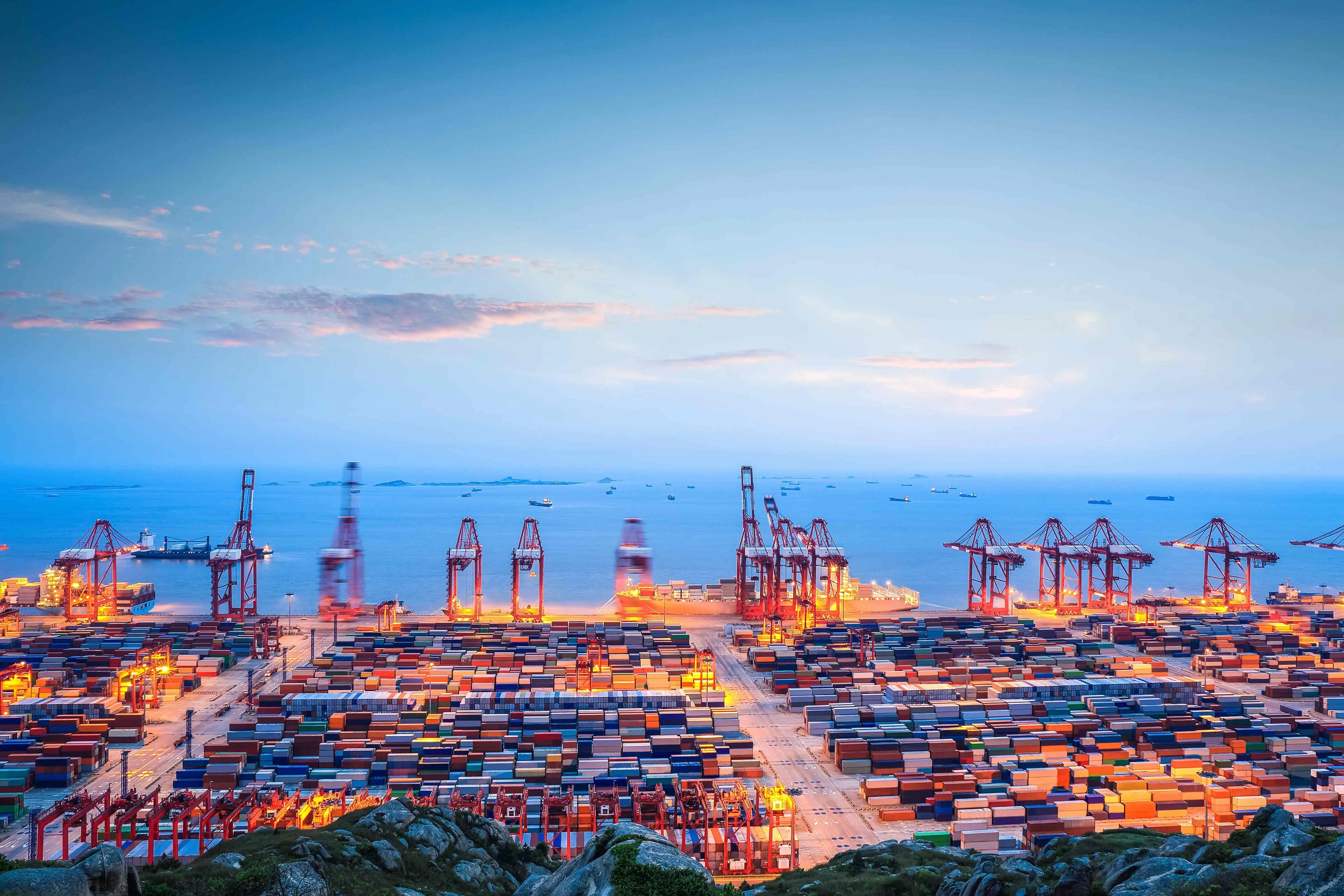
JUSDA Solutions
To provide you with professional solutions and quotations.
To do well in cross-border ecommerce logistics in 2025, try these steps. Use semi-managed logistics models so you can change your plans easily. Buy advanced management systems to see your inventory in real time. Use market data to guess what people will buy. Set alerts for your inventory so you never run out. Split your stock into groups to control it better. Look at JUSDA and China-Europe Express Rail for smarter ways to ship.
See Also
Revealing New Approaches To Supplier Partnerships In Global E-commerce
How Supply Chain Transparency Drives Success In Worldwide E-commerce
Exploring The Future Of Logistics Through Advanced Digital Tools
Comprehensive Insights Into Leading Global Logistics Firms Today
Discover The Latest Trends In Sea Freight Logistics For 2024
